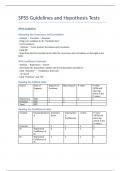Samenvatting
Summary SPSS Guideline and Hypotheses Testing for Regressions
- Instelling
- Tilburg University (UVT)
The document is an SPSS guideline on obtaining the covariance, correlation, confidence intervals, reading the ANOVA table, the coefficients table, interaction terms, dummy variables, and testing the model assumptions. Additionally, I provided a summary of when to use what test and when to reject th...
[Meer zien]





